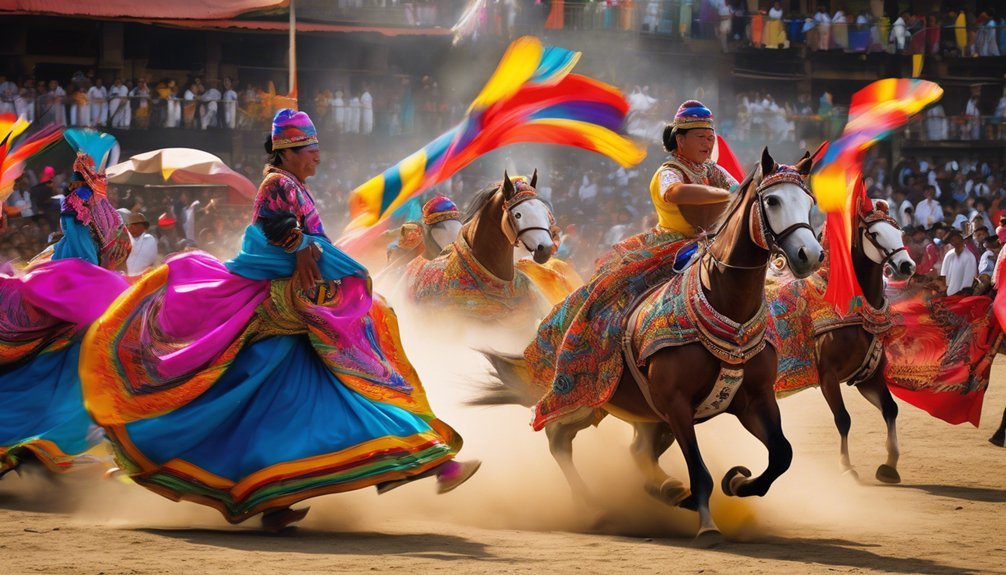
Did you know that equine-assisted therapy can improve balance and coordination by up to 80% in some individuals? This remarkable statistic highlights the profound impact horses can have on physical rehabilitation. As you explore the ways in which these gentle giants facilitate healing, you'll uncover the unique bond that forms between horse and human, paving the way for both physical and emotional recovery. What makes this connection so powerful?
Key Takeaways
- Horses provide rhythmic movement that aids in improving gait and overall coordination during rehabilitation exercises.
- Interaction with horses enhances muscle strength through activities like grooming and mounting.
- Gentle exercise with horses supports injury recovery and addresses physical challenges effectively.
- Equine-assisted therapy fosters emotional healing, contributing to better physical outcomes through reduced anxiety and elevated mood.
- Personalized rehabilitation programs involving horses cater to individual needs, promoting empowerment and progress at one's own pace.
The Therapeutic Bond Between Horse and Human

When you interact with a horse, you might notice an immediate connection that feels both powerful and profound. This bond, rooted in equine empathy, allows you to build trust not only with the horse but also within yourself.
Horses are incredibly sensitive creatures; they can sense your emotions and respond to your energy. As you spend time together, you'll discover that this relationship fosters a safe space for vulnerability and healing.
By engaging in activities like grooming or simply being present, you cultivate a deeper understanding of each other. This trust building creates an emotional foundation, enabling you to explore your feelings and fears.
The therapeutic bond with a horse can lead to transformative experiences, enriching your journey toward personal growth.
Physical Benefits of Equine-Assisted Therapy
As you engage in equine-assisted therapy, you'll likely notice a variety of physical benefits that come from your interactions with horses. One of the most significant advantages is gait improvement. The rhythmic movement of the horse stimulates your own muscles, helping to restore balance and coordination. You may find that your walking becomes smoother and more stable over time.
Additionally, working with horses can enhance your muscle strength. The physical activities involved, like grooming and mounting, require you to engage different muscle groups, promoting overall strength and endurance.
This gentle yet effective exercise can be especially beneficial if you're recovering from an injury or dealing with a physical challenge. Embrace these changes, and enjoy the journey toward greater physical wellness.
Emotional and Psychological Advantages
Engaging with horses in therapy not only fosters physical recovery but also nurtures your emotional and psychological well-being.
These beautiful creatures provide emotional support that can be profoundly comforting during challenging times. As you interact with them, you may find a sense of calm that encourages psychological healing, allowing you to process feelings and experiences in a safe space.
The bond you form with a horse can help reduce anxiety and elevate your mood, promoting resilience and self-acceptance. You might discover that simply being near a horse helps you feel more connected and understood, fostering a sense of belonging.
Personalized Rehabilitation Programs

Personalized rehabilitation programs can significantly enhance your recovery journey by tailoring therapy to meet your unique needs and goals. By incorporating horses into your sessions, therapists can create customized sessions that focus on both physical and emotional healing. You'll experience adaptive techniques designed to engage you, building strength while fostering connection with the horse.
| Session Focus | Adaptive Technique |
|---|---|
| Balance and Stability | Equine-assisted exercises |
| Strength Building | Groundwork activities |
| Emotional Regulation | Mindfulness while riding |
These personalized approaches help you progress at your own pace, ensuring you feel supported and empowered throughout your rehabilitation. Remember, each step taken with your horse is a step towards holistic healing.
Success Stories and Case Studies
Horses have transformed countless lives through rehabilitation, serving as powerful catalysts for healing.
You'll find many inspiring equine success stories that highlight the profound impact of these majestic animals on rehabilitation journeys.
Here are three remarkable examples:
- Sarah's Journey: After a serious injury, Sarah regained her strength and confidence through working with a gentle mare, who helped her rediscover joy in movement.
- Mark's Triumph: Mark, a veteran, found solace and emotional healing through equine therapy, forming a deep bond with his horse that eased his PTSD symptoms.
- Emily's Growth: A young girl with cerebral palsy learned to walk with the help of specially trained therapy horses, making incredible strides in her mobility.
These stories remind us of the healing power horses bring into our lives.
Frequently Asked Questions
What Qualifications Do Therapists Need for Equine-Assisted Therapy?
To practice equine-assisted therapy, you'll need specific certification requirements and training in therapy techniques. It's essential to blend your passion for animals with knowledge, ensuring a safe, supportive environment for those seeking healing and growth.
How Long Does a Typical Therapy Session Last?
When it comes to therapy sessions, you'll find they typically last around 45 to 60 minutes. This duration allows for meaningful engagement, maximizing therapeutic benefits while ensuring you feel comfortable and supported throughout the experience.
Are There Specific Breeds of Horses Used in Therapy?
Yes, there are specific therapeutic breeds known for their gentle temperaments and calming equine characteristics. Breeds like the American Quarter Horse and Thoroughbred often excel in therapy due to their responsive, patient nature, fostering emotional connections.
Can Children Participate in Equine-Assisted Therapy?
Absolutely, children can participate in equine-assisted therapy! They often experience significant benefits, helping them reach therapy goals while building confidence and emotional resilience. It's a nurturing space where they can thrive alongside these gentle creatures.
What Safety Measures Are in Place During Sessions?
During sessions, safety protocols ensure your well-being. Trained staff provide constant rider supervision, creating a secure environment. You can feel safe while enjoying the therapeutic benefits, knowing experienced professionals are dedicated to your safety and comfort.
Conclusion
In the journey of recovery, horses can be like gentle guides, leading you toward healing and strength. By forming a unique bond with these magnificent creatures, you're not just rehabilitating your body; you're also nurturing your spirit. The rhythmic movement of riding and the connection you share can transform your path to wellness. Embrace this opportunity, and let the power of equine therapy help you reclaim your balance and confidence in life.





